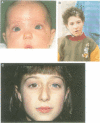Abstract
Auditory-pigmentary syndromes are caused by physical absence of melanocytes from the skin, hair, eyes, or the stria vascularis of the cochlea. Dominantly inherited examples with patchy depigmentation are usually labelled Waardenburg syndrome (WS). Type I WS, characterised by dystopia canthorum, is caused by loss of function mutations in the PAX3 gene. Type III WS (Klein-Waardenburg syndrome, with abnormalities of the arms) is an extreme presentation of type I; some but not all patients are homozygotes. Type IV WS (Shah-Waardenburg syndrome with Hirschsprung disease) can be caused by mutations in the genes for endothelin-3 or one of its receptors, EDNRB. Type II WS is a heterogeneous group, about 15% of whom are heterozygous for mutations in the MITF (microphthalmia associated transcription factor) gene. All these forms show marked variability even within families, and at present it is not possible to predict the severity, even when a mutation is detected. Characterising the genes is helping to unravel important developmental pathways in the neural crest and its derivatives.
Full text
PDF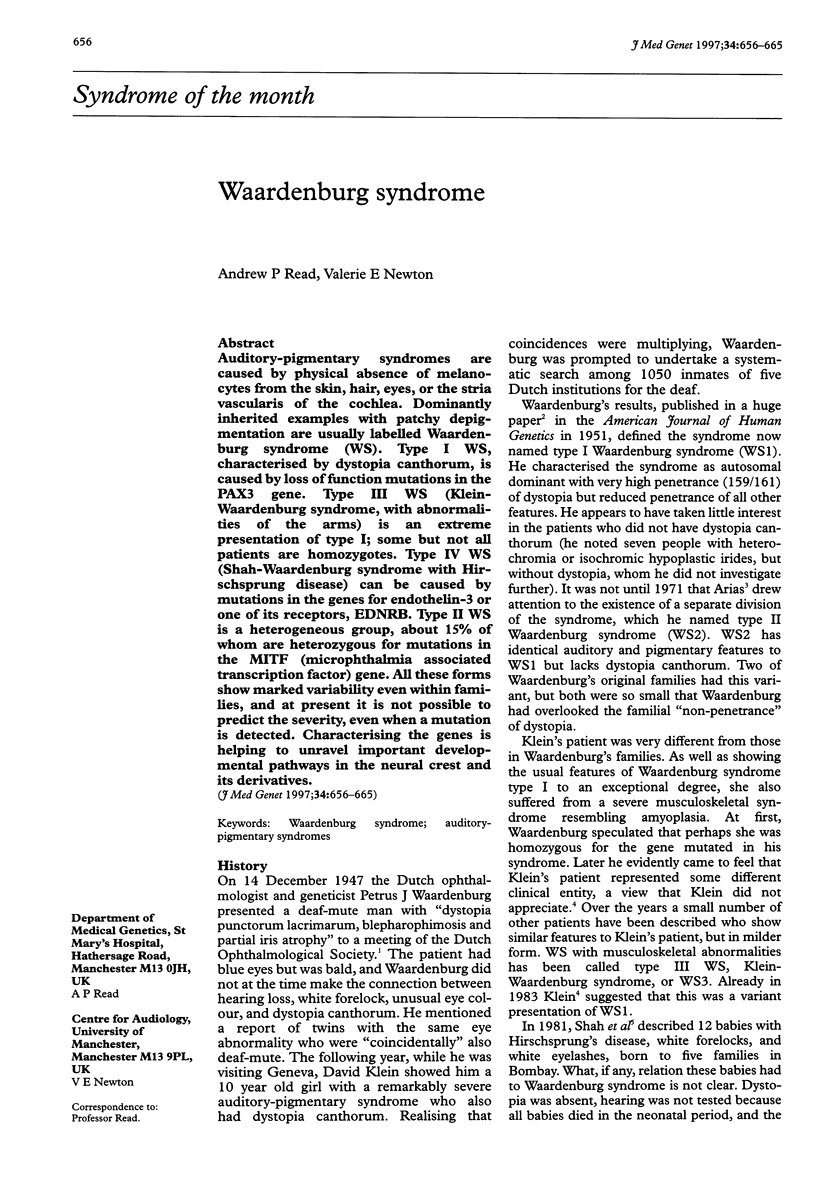
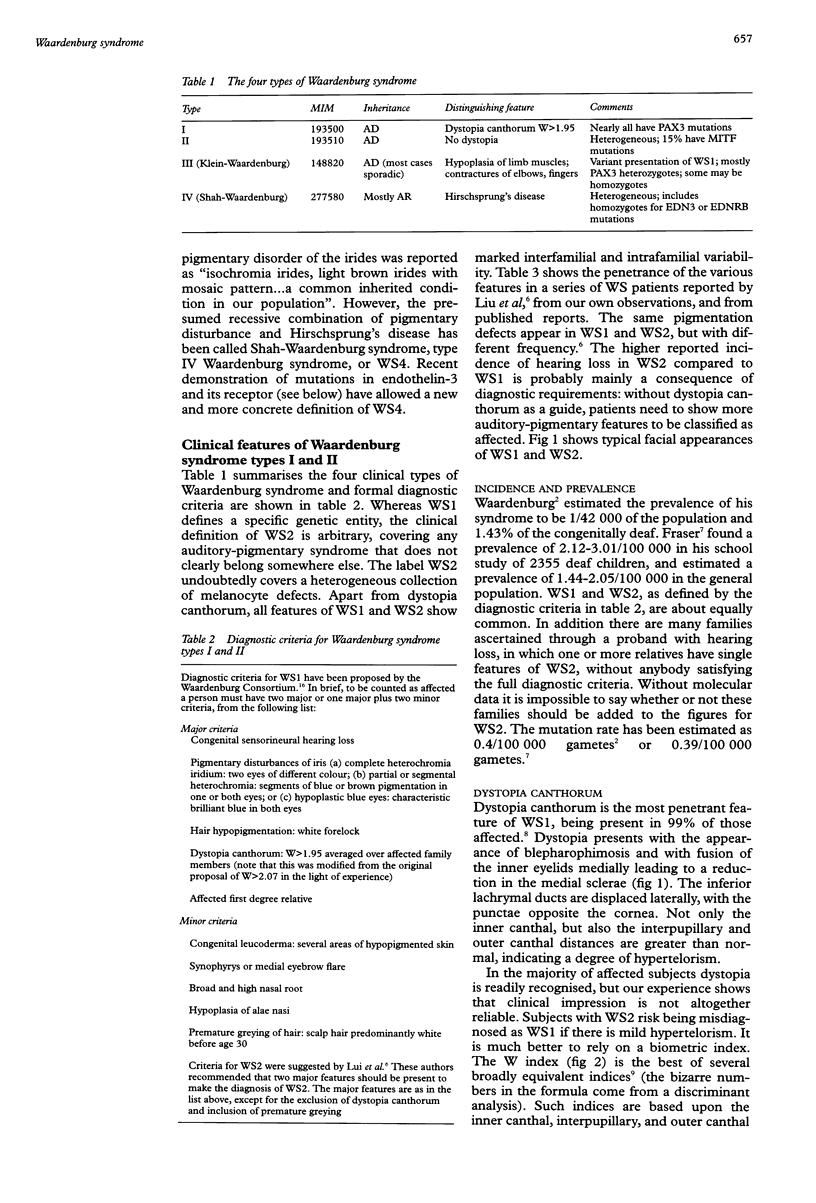
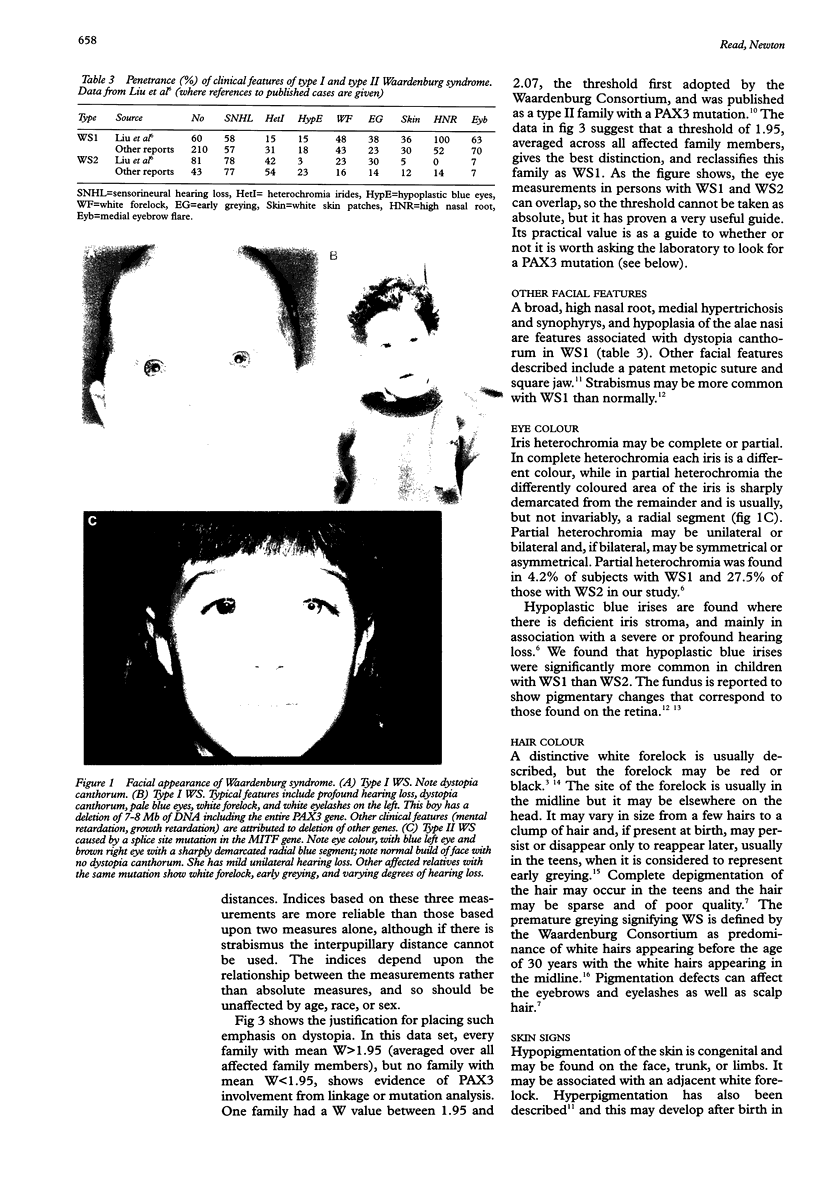
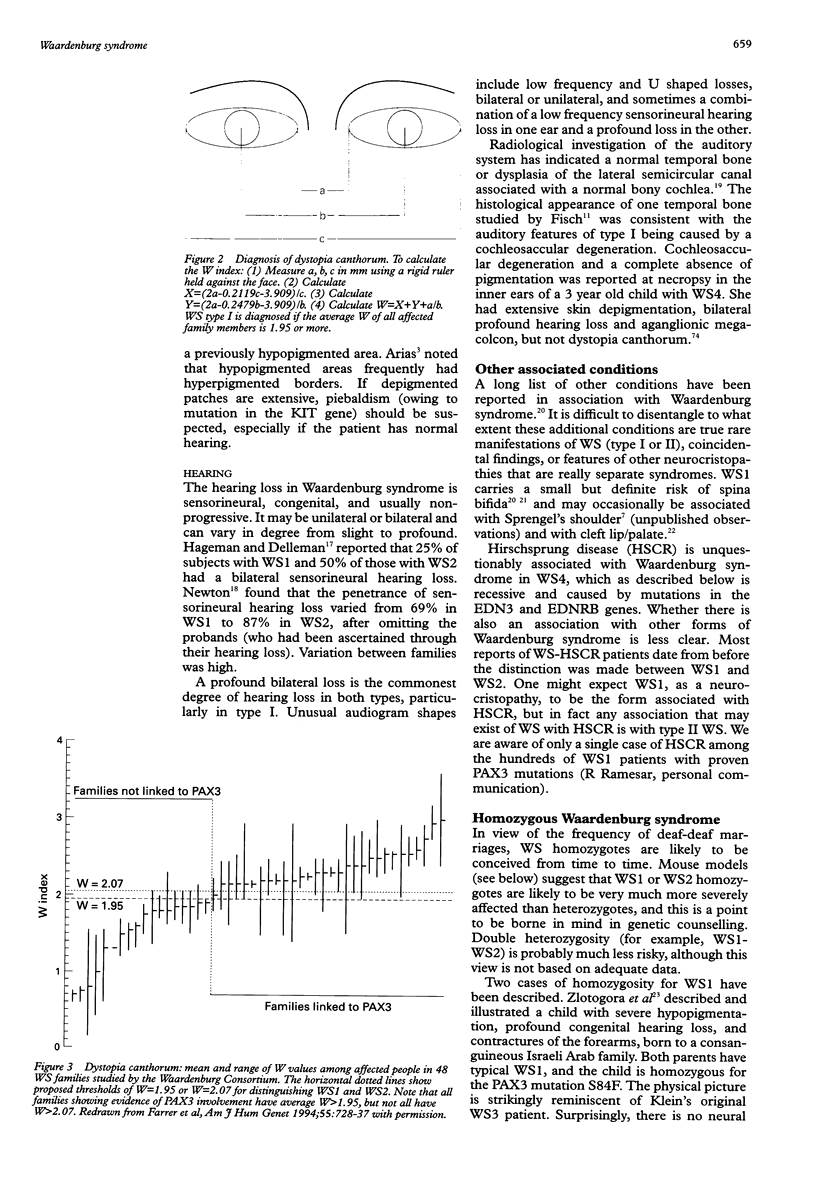
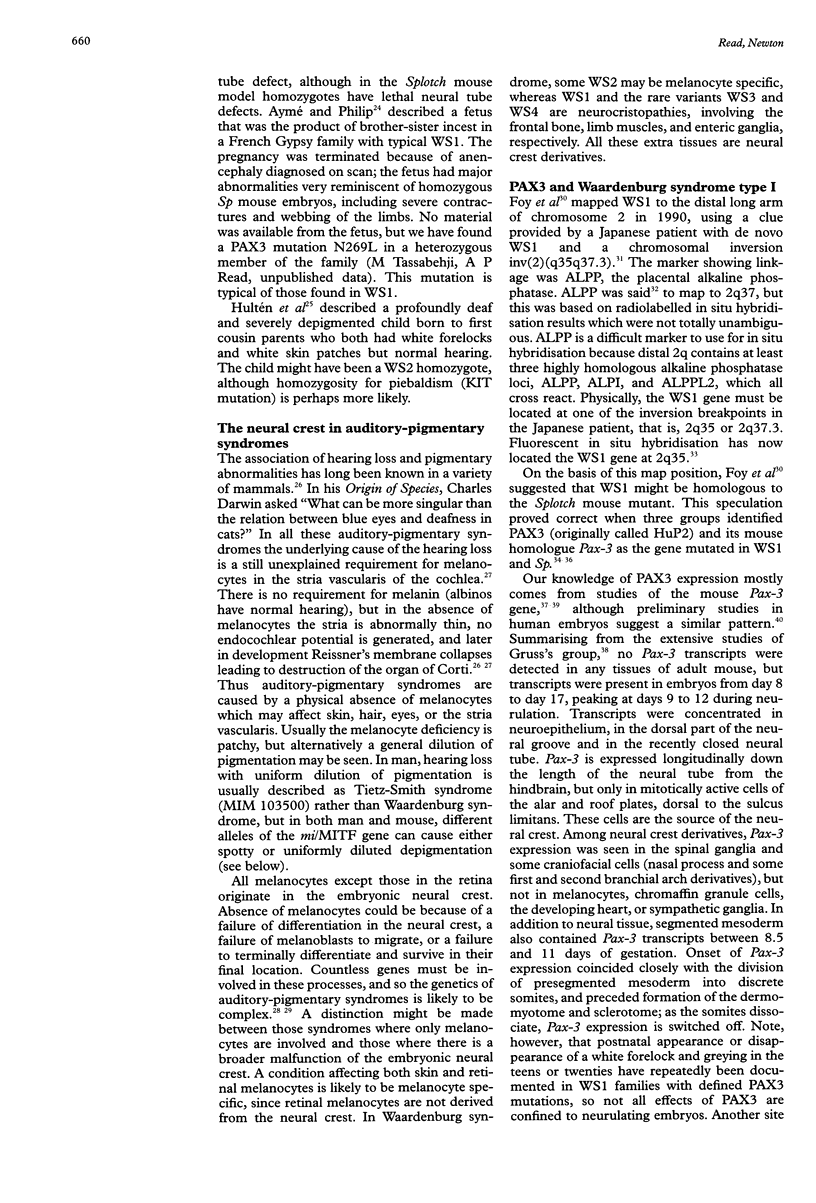
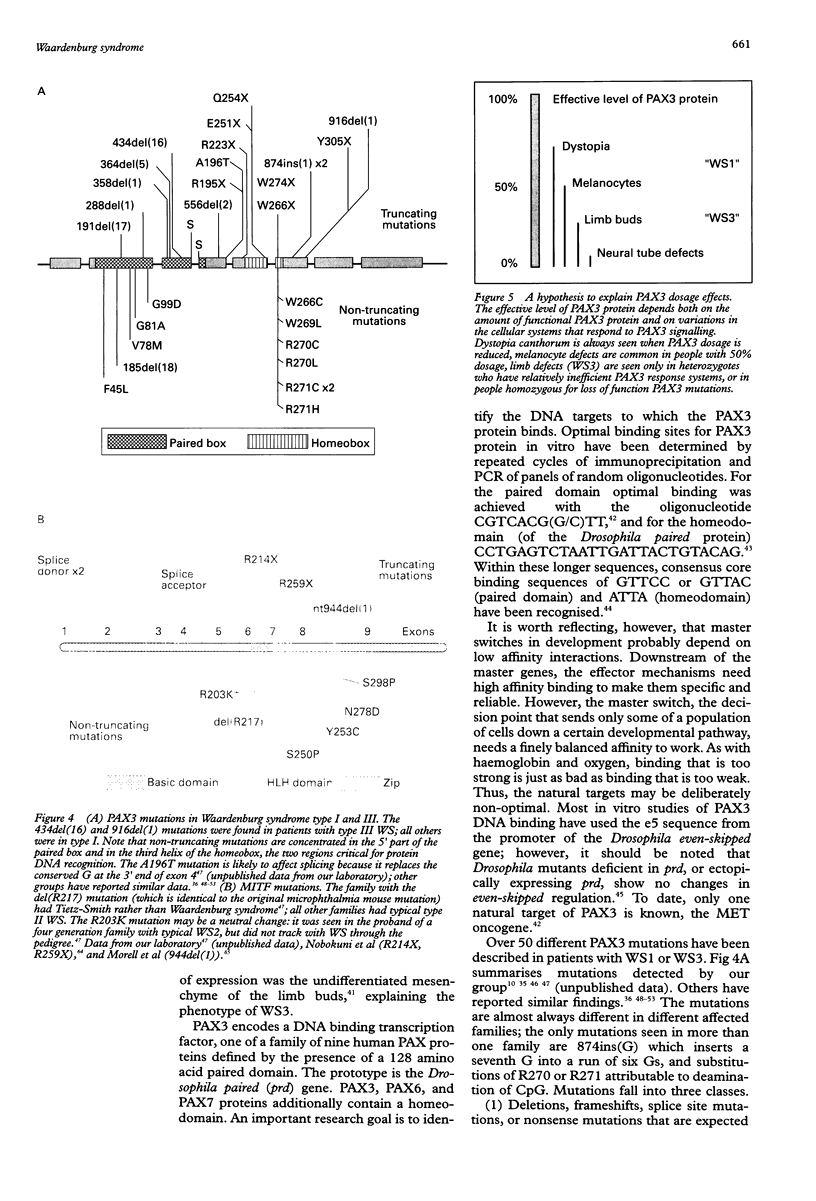
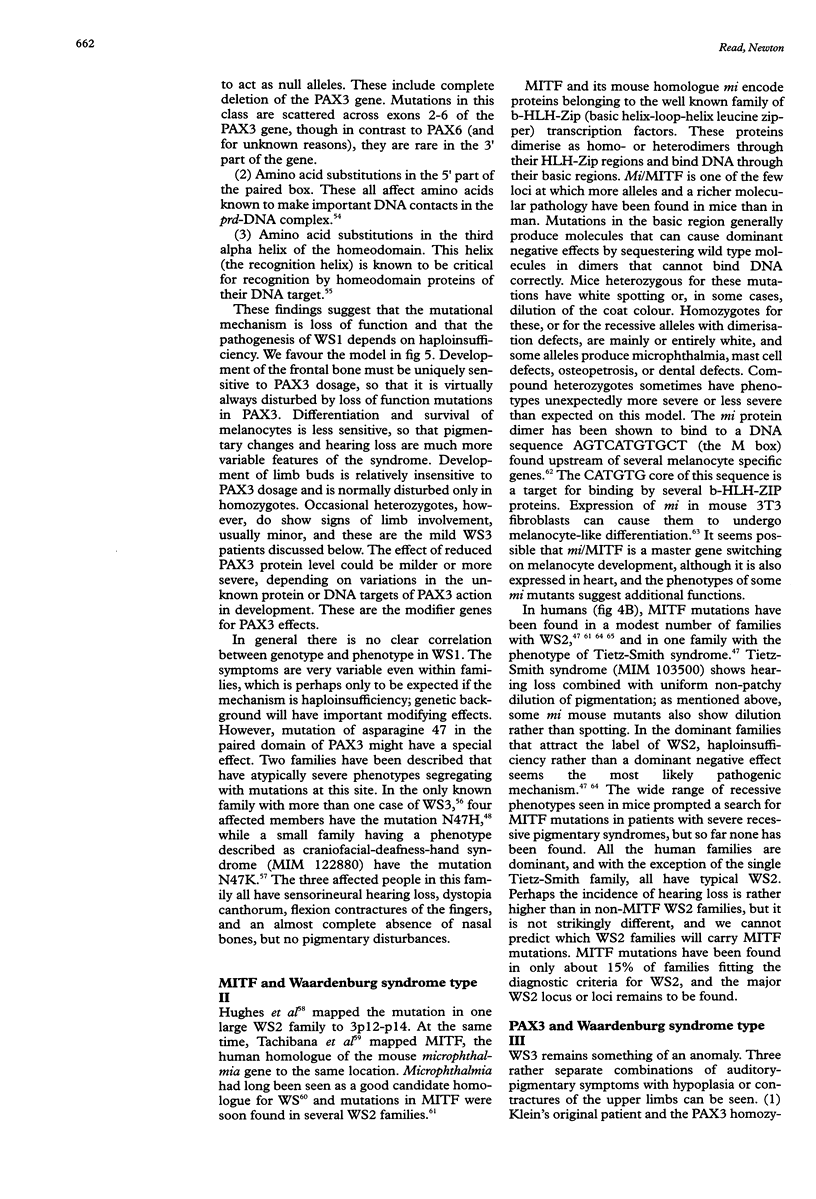
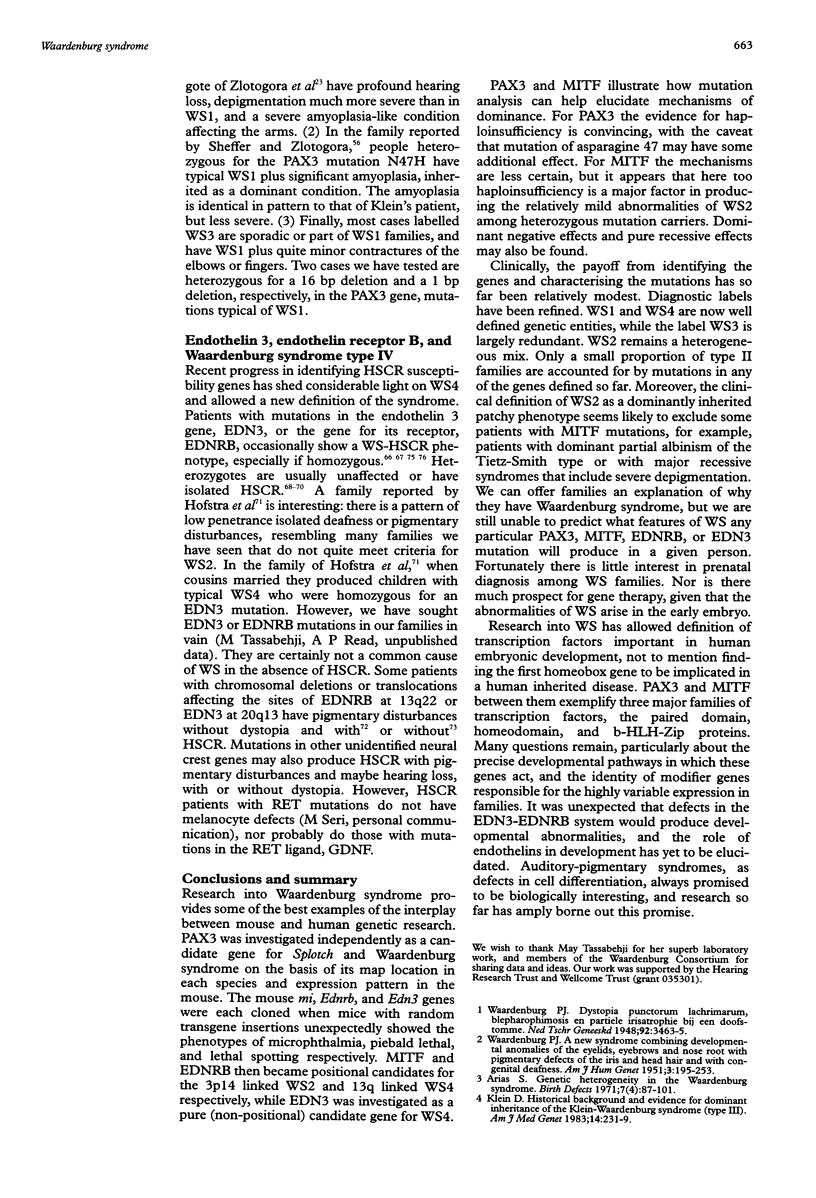
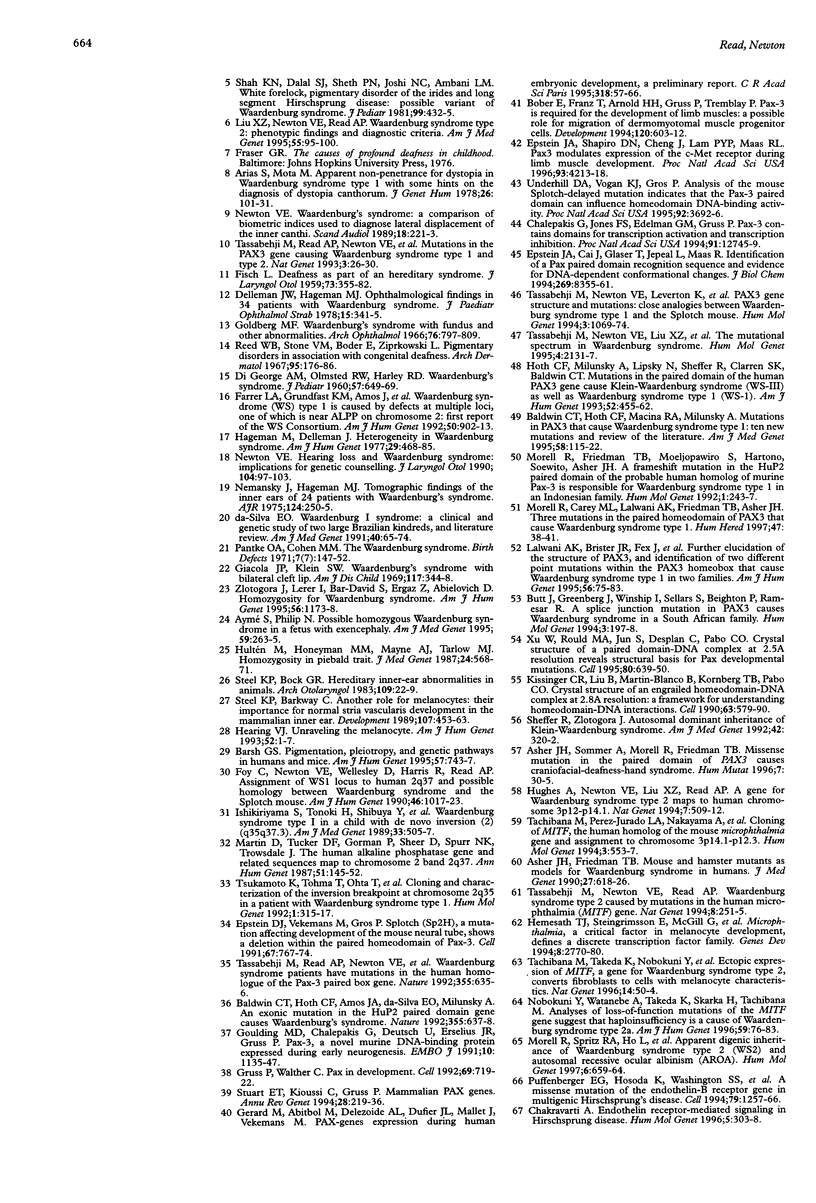

Images in this article
Selected References
These references are in PubMed. This may not be the complete list of references from this article.
- Amiel J., Attié T., Jan D., Pelet A., Edery P., Bidaud C., Lacombe D., Tam P., Simeoni J., Flori E. Heterozygous endothelin receptor B (EDNRB) mutations in isolated Hirschsprung disease. Hum Mol Genet. 1996 Mar;5(3):355–357. doi: 10.1093/hmg/5.3.355. [DOI] [PubMed] [Google Scholar]
- Asher J. H., Jr, Friedman T. B. Mouse and hamster mutants as models for Waardenburg syndromes in humans. J Med Genet. 1990 Oct;27(10):618–626. doi: 10.1136/jmg.27.10.618. [DOI] [PMC free article] [PubMed] [Google Scholar]
- Asher J. H., Jr, Sommer A., Morell R., Friedman T. B. Missense mutation in the paired domain of PAX3 causes craniofacial-deafness-hand syndrome. Hum Mutat. 1996;7(1):30–35. doi: 10.1002/(SICI)1098-1004(1996)7:1<30::AID-HUMU4>3.0.CO;2-T. [DOI] [PubMed] [Google Scholar]
- Attié T., Till M., Pelet A., Amiel J., Edery P., Boutrand L., Munnich A., Lyonnet S. Mutation of the endothelin-receptor B gene in Waardenburg-Hirschsprung disease. Hum Mol Genet. 1995 Dec;4(12):2407–2409. doi: 10.1093/hmg/4.12.2407. [DOI] [PubMed] [Google Scholar]
- Auricchio A., Casari G., Staiano A., Ballabio A. Endothelin-B receptor mutations in patients with isolated Hirschsprung disease from a non-inbred population. Hum Mol Genet. 1996 Mar;5(3):351–354. doi: 10.1093/hmg/5.3.351. [DOI] [PubMed] [Google Scholar]
- Aymé S., Philip N. Possible homozygous Waardenburg syndrome in a fetus with exencephaly. Am J Med Genet. 1995 Nov 6;59(2):263–265. doi: 10.1002/ajmg.1320590227. [DOI] [PubMed] [Google Scholar]
- Baldwin C. T., Hoth C. F., Amos J. A., da-Silva E. O., Milunsky A. An exonic mutation in the HuP2 paired domain gene causes Waardenburg's syndrome. Nature. 1992 Feb 13;355(6361):637–638. doi: 10.1038/355637a0. [DOI] [PubMed] [Google Scholar]
- Baldwin C. T., Hoth C. F., Macina R. A., Milunsky A. Mutations in PAX3 that cause Waardenburg syndrome type I: ten new mutations and review of the literature. Am J Med Genet. 1995 Aug 28;58(2):115–122. doi: 10.1002/ajmg.1320580205. [DOI] [PubMed] [Google Scholar]
- Barsh G. S. Pigmentation, pleiotropy, and genetic pathways in humans and mice. Am J Hum Genet. 1995 Oct;57(4):743–747. [PMC free article] [PubMed] [Google Scholar]
- Bober E., Franz T., Arnold H. H., Gruss P., Tremblay P. Pax-3 is required for the development of limb muscles: a possible role for the migration of dermomyotomal muscle progenitor cells. Development. 1994 Mar;120(3):603–612. doi: 10.1242/dev.120.3.603. [DOI] [PubMed] [Google Scholar]
- Butt J., Greenberg J., Winship I., Sellars S., Beighton P., Ramesar R. A splice junction mutation in PAX3 causes Waardenburg syndrome in a South African family. Hum Mol Genet. 1994 Jan;3(1):197–198. doi: 10.1093/hmg/3.1.197. [DOI] [PubMed] [Google Scholar]
- Chakravarti A. Endothelin receptor-mediated signaling in hirschsprung disease. Hum Mol Genet. 1996 Mar;5(3):303–307. [PubMed] [Google Scholar]
- Chalepakis G., Jones F. S., Edelman G. M., Gruss P. Pax-3 contains domains for transcription activation and transcription inhibition. Proc Natl Acad Sci U S A. 1994 Dec 20;91(26):12745–12749. doi: 10.1073/pnas.91.26.12745. [DOI] [PMC free article] [PubMed] [Google Scholar]
- DIGEORGE A. M., OLMSTED R. W., HARLEY R. D. Waardenburg's syndrome. A syndrome of heterochromia of the irides, lateral displacement of the medial canthi and lacrimal puncta, congenital deafness, and other characteristic associated defects. J Pediatr. 1960 Nov;57:649–669. doi: 10.1016/s0022-3476(60)80159-x. [DOI] [PubMed] [Google Scholar]
- Delleman J. W., Hageman M. J. Ophthalmological findings in 34 patients with Waardenburg syndrome. J Pediatr Ophthalmol Strabismus. 1978 Nov-Dec;15(6):341–345. doi: 10.3928/0191-3913-19781101-03. [DOI] [PubMed] [Google Scholar]
- Edery P., Attié T., Amiel J., Pelet A., Eng C., Hofstra R. M., Martelli H., Bidaud C., Munnich A., Lyonnet S. Mutation of the endothelin-3 gene in the Waardenburg-Hirschsprung disease (Shah-Waardenburg syndrome). Nat Genet. 1996 Apr;12(4):442–444. doi: 10.1038/ng0496-442. [DOI] [PubMed] [Google Scholar]
- Epstein D. J., Vekemans M., Gros P. Splotch (Sp2H), a mutation affecting development of the mouse neural tube, shows a deletion within the paired homeodomain of Pax-3. Cell. 1991 Nov 15;67(4):767–774. doi: 10.1016/0092-8674(91)90071-6. [DOI] [PubMed] [Google Scholar]
- Epstein J. A., Shapiro D. N., Cheng J., Lam P. Y., Maas R. L. Pax3 modulates expression of the c-Met receptor during limb muscle development. Proc Natl Acad Sci U S A. 1996 Apr 30;93(9):4213–4218. doi: 10.1073/pnas.93.9.4213. [DOI] [PMC free article] [PubMed] [Google Scholar]
- Epstein J., Cai J., Glaser T., Jepeal L., Maas R. Identification of a Pax paired domain recognition sequence and evidence for DNA-dependent conformational changes. J Biol Chem. 1994 Mar 18;269(11):8355–8361. [PubMed] [Google Scholar]
- FISCH L. Deafness as part of an hereditary syndrome. J Laryngol Otol. 1959 Jun;73:355–382. doi: 10.1017/s0022215100055420. [DOI] [PubMed] [Google Scholar]
- Farrer L. A., Grundfast K. M., Amos J., Arnos K. S., Asher J. H., Jr, Beighton P., Diehl S. R., Fex J., Foy C., Friedman T. B. Waardenburg syndrome (WS) type I is caused by defects at multiple loci, one of which is near ALPP on chromosome 2: first report of the WS consortium. Am J Hum Genet. 1992 May;50(5):902–913. [PMC free article] [PubMed] [Google Scholar]
- Foy C., Newton V., Wellesley D., Harris R., Read A. P. Assignment of the locus for Waardenburg syndrome type I to human chromosome 2q37 and possible homology to the Splotch mouse. Am J Hum Genet. 1990 Jun;46(6):1017–1023. [PMC free article] [PubMed] [Google Scholar]
- Giacoia J. P., Klein S. W. Waardenburg's syndrome with bilateral cleft lip. Am J Dis Child. 1969 Mar;117(3):344–348. doi: 10.1001/archpedi.1969.02100030346020. [DOI] [PubMed] [Google Scholar]
- Goldberg M. F. Waardenburg's syndrome with fundus and other anomalies. Arch Ophthalmol. 1966 Dec;76(6):797–810. doi: 10.1001/archopht.1966.03850010799005. [DOI] [PubMed] [Google Scholar]
- Gorlin R. J., Schlorf R. A., Paparella M. M. Cleft palate, stapes fixation and oligodontia--a new autosomal recessively inherited syndrome. Birth Defects Orig Artic Ser. 1971 Jun;7(7):87–88. [PubMed] [Google Scholar]
- Goulding M. D., Chalepakis G., Deutsch U., Erselius J. R., Gruss P. Pax-3, a novel murine DNA binding protein expressed during early neurogenesis. EMBO J. 1991 May;10(5):1135–1147. doi: 10.1002/j.1460-2075.1991.tb08054.x. [DOI] [PMC free article] [PubMed] [Google Scholar]
- Gruss P., Walther C. Pax in development. Cell. 1992 May 29;69(5):719–722. doi: 10.1016/0092-8674(92)90281-g. [DOI] [PubMed] [Google Scholar]
- Gérard M., Abitbol M., Delezoide A. L., Dufier J. L., Mallet J., Vekemans M. PAX-genes expression during human embryonic development, a preliminary report. C R Acad Sci III. 1995 Jan;318(1):57–66. [PubMed] [Google Scholar]
- Hageman M. J., Delleman J. W. Heterogeneity in Waardenburg syndrome. Am J Hum Genet. 1977 Sep;29(5):468–485. [PMC free article] [PubMed] [Google Scholar]
- Hearing V. J. Unraveling the melanocyte. Am J Hum Genet. 1993 Jan;52(1):1–7. [PMC free article] [PubMed] [Google Scholar]
- Hemesath T. J., Steingrímsson E., McGill G., Hansen M. J., Vaught J., Hodgkinson C. A., Arnheiter H., Copeland N. G., Jenkins N. A., Fisher D. E. microphthalmia, a critical factor in melanocyte development, defines a discrete transcription factor family. Genes Dev. 1994 Nov 15;8(22):2770–2780. doi: 10.1101/gad.8.22.2770. [DOI] [PubMed] [Google Scholar]
- Hofstra R. M., Osinga J., Tan-Sindhunata G., Wu Y., Kamsteeg E. J., Stulp R. P., van Ravenswaaij-Arts C., Majoor-Krakauer D., Angrist M., Chakravarti A. A homozygous mutation in the endothelin-3 gene associated with a combined Waardenburg type 2 and Hirschsprung phenotype (Shah-Waardenburg syndrome). Nat Genet. 1996 Apr;12(4):445–447. doi: 10.1038/ng0496-445. [DOI] [PubMed] [Google Scholar]
- Hoth C. F., Milunsky A., Lipsky N., Sheffer R., Clarren S. K., Baldwin C. T. Mutations in the paired domain of the human PAX3 gene cause Klein-Waardenburg syndrome (WS-III) as well as Waardenburg syndrome type I (WS-I). Am J Hum Genet. 1993 Mar;52(3):455–462. [PMC free article] [PubMed] [Google Scholar]
- Hughes A. E., Newton V. E., Liu X. Z., Read A. P. A gene for Waardenburg syndrome type 2 maps close to the human homologue of the microphthalmia gene at chromosome 3p12-p14.1. Nat Genet. 1994 Aug;7(4):509–512. doi: 10.1038/ng0894-509. [DOI] [PubMed] [Google Scholar]
- Hultén M. A., Honeyman M. M., Mayne A. J., Tarlow M. J. Homozygosity in piebald trait. J Med Genet. 1987 Sep;24(9):568–571. doi: 10.1136/jmg.24.9.568. [DOI] [PMC free article] [PubMed] [Google Scholar]
- Ishikiriyama S., Tonoki H., Shibuya Y., Chin S., Harada N., Abe K., Niikawa N. Waardenburg syndrome type I in a child with de novo inversion (2)(q35q37.3). Am J Med Genet. 1989 Aug;33(4):505–507. doi: 10.1002/ajmg.1320330419. [DOI] [PubMed] [Google Scholar]
- Kissinger C. R., Liu B. S., Martin-Blanco E., Kornberg T. B., Pabo C. O. Crystal structure of an engrailed homeodomain-DNA complex at 2.8 A resolution: a framework for understanding homeodomain-DNA interactions. Cell. 1990 Nov 2;63(3):579–590. doi: 10.1016/0092-8674(90)90453-l. [DOI] [PubMed] [Google Scholar]
- Klein D. Historical background and evidence for dominant inheritance of the Klein-Waardenburg syndrome (type III). Am J Med Genet. 1983 Feb;14(2):231–239. doi: 10.1002/ajmg.1320140205. [DOI] [PubMed] [Google Scholar]
- Kusafuka T., Wang Y., Puri P. Novel mutations of the endothelin-B receptor gene in isolated patients with Hirschsprung's disease. Hum Mol Genet. 1996 Mar;5(3):347–349. doi: 10.1093/hmg/5.3.347. [DOI] [PubMed] [Google Scholar]
- Lalwani A. K., Brister J. R., Fex J., Grundfast K. M., Ploplis B., San Agustin T. B., Wilcox E. R. Further elucidation of the genomic structure of PAX3, and identification of two different point mutations within the PAX3 homeobox that cause Waardenburg syndrome type 1 in two families. Am J Hum Genet. 1995 Jan;56(1):75–83. [PMC free article] [PubMed] [Google Scholar]
- Liu X. Z., Newton V. E., Read A. P. Waardenburg syndrome type II: phenotypic findings and diagnostic criteria. Am J Med Genet. 1995 Jan 2;55(1):95–100. doi: 10.1002/ajmg.1320550123. [DOI] [PubMed] [Google Scholar]
- Martin D., Tucker D. F., Gorman P., Sheer D., Spurr N. K., Trowsdale J. The human placental alkaline phosphatase gene and related sequences map to chromosome 2 band q37. Ann Hum Genet. 1987 May;51(Pt 2):145–152. doi: 10.1111/j.1469-1809.1987.tb01056.x. [DOI] [PubMed] [Google Scholar]
- Morell R., Carey M. L., Lalwani A. K., Friedman T. B., Asher J. H., Jr Three mutations in the paired homeodomain of PAX3 that cause Waardenburg syndrome type 1. Hum Hered. 1997 Jan-Feb;47(1):38–41. doi: 10.1159/000154387. [DOI] [PubMed] [Google Scholar]
- Morell R., Friedman T. B., Moeljopawiro S., Hartono, Soewito, Asher J. H., Jr A frameshift mutation in the HuP2 paired domain of the probable human homolog of murine Pax-3 is responsible for Waardenburg syndrome type 1 in an Indonesian family. Hum Mol Genet. 1992 Jul;1(4):243–247. doi: 10.1093/hmg/1.4.243. [DOI] [PubMed] [Google Scholar]
- Morell R., Spritz R. A., Ho L., Pierpont J., Guo W., Friedman T. B., Asher J. H., Jr Apparent digenic inheritance of Waardenburg syndrome type 2 (WS2) and autosomal recessive ocular albinism (AROA). Hum Mol Genet. 1997 May;6(5):659–664. doi: 10.1093/hmg/6.5.659. [DOI] [PubMed] [Google Scholar]
- Nakashima S., Sando I., Takahashi H., Hashida Y. Temporal bone histopathologic findings of Waardenburg's syndrome: a case report. Laryngoscope. 1992 May;102(5):563–567. doi: 10.1288/00005537-199205000-00016. [DOI] [PubMed] [Google Scholar]
- Nemansky J., Hageman M. J. Tomographic findings of the inner ears of 24 patients with Waardenburg's syndrome. Am J Roentgenol Radium Ther Nucl Med. 1975 Jun;124(2):250–255. doi: 10.2214/ajr.124.2.250. [DOI] [PubMed] [Google Scholar]
- Newton V. E. Waardenburg's syndrome: a comparison of biometric indices used to diagnose lateral displacement of the inner canthi. Scand Audiol. 1989;18(4):221–223. doi: 10.3109/01050398909042198. [DOI] [PubMed] [Google Scholar]
- Newton V. Hearing loss and Waardenburg's syndrome: implications for genetic counselling. J Laryngol Otol. 1990 Feb;104(2):97–103. doi: 10.1017/s002221510011196x. [DOI] [PubMed] [Google Scholar]
- Nobukuni Y., Watanabe A., Takeda K., Skarka H., Tachibana M. Analyses of loss-of-function mutations of the MITF gene suggest that haploinsufficiency is a cause of Waardenburg syndrome type 2A. Am J Hum Genet. 1996 Jul;59(1):76–83. [PMC free article] [PubMed] [Google Scholar]
- Pantke O. A., Cohen M. M., Jr The Waardenburg syndrome. Birth Defects Orig Artic Ser. 1971 Jun;7(7):147–152. [PubMed] [Google Scholar]
- Puffenberger E. G., Hosoda K., Washington S. S., Nakao K., deWit D., Yanagisawa M., Chakravart A. A missense mutation of the endothelin-B receptor gene in multigenic Hirschsprung's disease. Cell. 1994 Dec 30;79(7):1257–1266. doi: 10.1016/0092-8674(94)90016-7. [DOI] [PubMed] [Google Scholar]
- Reed W. B., Stone V. M., Boder E., Ziprkowski L. Pigmentary disorders in association with congenital deafness. Arch Dermatol. 1967 Feb;95(2):176–186. [PubMed] [Google Scholar]
- Sheffer R., Zlotogora J. Autosomal dominant inheritance of Klein-Waardenburg syndrome. Am J Med Genet. 1992 Feb 1;42(3):320–322. doi: 10.1002/ajmg.1320420312. [DOI] [PubMed] [Google Scholar]
- Steel K. P., Barkway C. Another role for melanocytes: their importance for normal stria vascularis development in the mammalian inner ear. Development. 1989 Nov;107(3):453–463. doi: 10.1242/dev.107.3.453. [DOI] [PubMed] [Google Scholar]
- Steel K. P., Bock G. R. Hereditary inner-ear abnormalities in animals. Relationships with human abnormalities. Arch Otolaryngol. 1983 Jan;109(1):22–29. doi: 10.1001/archotol.1983.00800150026005. [DOI] [PubMed] [Google Scholar]
- Stuart E. T., Kioussi C., Gruss P. Mammalian Pax genes. Annu Rev Genet. 1994;28:219–236. doi: 10.1146/annurev.ge.28.120194.001251. [DOI] [PubMed] [Google Scholar]
- Tachibana M., Perez-Jurado L. A., Nakayama A., Hodgkinson C. A., Li X., Schneider M., Miki T., Fex J., Francke U., Arnheiter H. Cloning of MITF, the human homolog of the mouse microphthalmia gene and assignment to chromosome 3p14.1-p12.3. Hum Mol Genet. 1994 Apr;3(4):553–557. doi: 10.1093/hmg/3.4.553. [DOI] [PubMed] [Google Scholar]
- Tachibana M., Takeda K., Nobukuni Y., Urabe K., Long J. E., Meyers K. A., Aaronson S. A., Miki T. Ectopic expression of MITF, a gene for Waardenburg syndrome type 2, converts fibroblasts to cells with melanocyte characteristics. Nat Genet. 1996 Sep;14(1):50–54. doi: 10.1038/ng0996-50. [DOI] [PubMed] [Google Scholar]
- Tassabehji M., Newton V. E., Leverton K., Turnbull K., Seemanova E., Kunze J., Sperling K., Strachan T., Read A. P. PAX3 gene structure and mutations: close analogies between Waardenburg syndrome and the Splotch mouse. Hum Mol Genet. 1994 Jul;3(7):1069–1074. doi: 10.1093/hmg/3.7.1069. [DOI] [PubMed] [Google Scholar]
- Tassabehji M., Newton V. E., Liu X. Z., Brady A., Donnai D., Krajewska-Walasek M., Murday V., Norman A., Obersztyn E., Reardon W. The mutational spectrum in Waardenburg syndrome. Hum Mol Genet. 1995 Nov;4(11):2131–2137. doi: 10.1093/hmg/4.11.2131. [DOI] [PubMed] [Google Scholar]
- Tassabehji M., Newton V. E., Read A. P. Waardenburg syndrome type 2 caused by mutations in the human microphthalmia (MITF) gene. Nat Genet. 1994 Nov;8(3):251–255. doi: 10.1038/ng1194-251. [DOI] [PubMed] [Google Scholar]
- Tassabehji M., Read A. P., Newton V. E., Harris R., Balling R., Gruss P., Strachan T. Waardenburg's syndrome patients have mutations in the human homologue of the Pax-3 paired box gene. Nature. 1992 Feb 13;355(6361):635–636. doi: 10.1038/355635a0. [DOI] [PubMed] [Google Scholar]
- Tassabehji M., Read A. P., Newton V. E., Patton M., Gruss P., Harris R., Strachan T. Mutations in the PAX3 gene causing Waardenburg syndrome type 1 and type 2. Nat Genet. 1993 Jan;3(1):26–30. doi: 10.1038/ng0193-26. [DOI] [PubMed] [Google Scholar]
- Tsukamoto K., Tohma T., Ohta T., Yamakawa K., Fukushima Y., Nakamura Y., Niikawa N. Cloning and characterization of the inversion breakpoint at chromosome 2q35 in a patient with Waardenburg syndrome type I. Hum Mol Genet. 1992 Aug;1(5):315–317. doi: 10.1093/hmg/1.5.315. [DOI] [PubMed] [Google Scholar]
- Underhill D. A., Vogan K. J., Gros P. Analysis of the mouse Splotch-delayed mutation indicates that the Pax-3 paired domain can influence homeodomain DNA-binding activity. Proc Natl Acad Sci U S A. 1995 Apr 25;92(9):3692–3696. doi: 10.1073/pnas.92.9.3692. [DOI] [PMC free article] [PubMed] [Google Scholar]
- Van Camp G., Van Thienen M. N., Handig I., Van Roy B., Rao V. S., Milunsky A., Read A. P., Baldwin C. T., Farrer L. A., Bonduelle M. Chromosome 13q deletion with Waardenburg syndrome: further evidence for a gene involved in neural crest function on 13q. J Med Genet. 1995 Jul;32(7):531–536. doi: 10.1136/jmg.32.7.531. [DOI] [PMC free article] [PubMed] [Google Scholar]
- Xu W., Rould M. A., Jun S., Desplan C., Pabo C. O. Crystal structure of a paired domain-DNA complex at 2.5 A resolution reveals structural basis for Pax developmental mutations. Cell. 1995 Feb 24;80(4):639–650. doi: 10.1016/0092-8674(95)90518-9. [DOI] [PubMed] [Google Scholar]
- Zlotogora J., Lerer I., Bar-David S., Ergaz Z., Abeliovich D. Homozygosity for Waardenburg syndrome. Am J Hum Genet. 1995 May;56(5):1173–1178. [PMC free article] [PubMed] [Google Scholar]



